Heh. Greetings.
Welcome back to another installment of Meta Breaker, the weekly series where I build a deck specifically to take down one or more decks in the Standard meta. As always, here’s what you can expect from this column each week:
- Analyzing the current meta and choosing what deck(s) we’d like to target.
- Assessing the strong and weak points of our target(s).
- Identifying cards and strategies that may prove effective against our target(s).
- Building an initial version of our deck and trying it out against the field.
- Continually refining the decklist using observations and statistics taken from test games.
Building for an Untested Meta
This time we’ve got a pretty unique situation - Hearthstone’s Doom in the Tomb event has just launched, and 23 powerful cards from older expansions and the Hall of Fame have been released back into Standard. We don’t really have a great idea yet of exactly what decks are now Tier 1 with everything being so fresh, which raises the obvious question - Can we even have a Meta Breaker this week? How the heck do we decide what to focus on?
I’d argue, however, that we actually do have plenty to focus on. As I’ve stated in previous articles, the best deck to target is usually going to be a deck with a high winrate that’s also being played a lot. Although we might not have much winrate data with the new cards right now, we can get a general idea of which cards have people the most excited, and can thus plan our deck against that general strategy.
The set of cards returning to Standard is extremely powerful, but many of the cards that have people talking the most have one theme in common: they lend themselves to high-power control decks. Emperor Thaurissan, Ragnaros the Firelord, Sylvanas Windrunner, and [Hearthstone Card (N’Zoth, the Corruptor) Not Found] are all extremely powerful control tools for every class. In particular, N’Zoth synergizes especially well with classes like Druid Warlock, and Priest, who also got valuable tools for their own N’Zoth decks- such as Astral Communion and Lightbomb- that help make those decks into real contenders. I’m sure many fans of these classic legendaries will be looking to play decks where they can use those cards in Standard again- as such we can expect a high frequency of these strategies in the next week or so.
Thus, our enemy this week is not a single deck, but rather the collection of N’Zoth-based control decks that people will likely be building and piloting in the next couple of days. Let’s take a look at some early lists I found on r/CompetitiveHS (The Priest deck was posted by u/Mario2544, and the Warlock one by u/AllGoldWhizzlebang):
How Does this Strategy Win?
After playing a few games with each of these decks, the N’Zoth gameplan certainly seems very powerful. In general, their plan is relatively simple: remove threats in the early game, play Taunts and board clears in the mid game, and drop N’Zoth once the game’s gone on long enough to resurrect a wall of Taunts (and maybe another Sylvanas). Resurrecting a board of Khartut Defender and Rotten Applebaum should be enough to go over the top of other control decks and stop Aggro in its tracks, which means this strategy should be solid against most decks. Both have very strong AoE removal and an insane late-game bomb that often just wins the game.
How Does this Strategy Lose?
Both of these decks, while powerful, are quite slow. The Priest deck, in particular, has very little early board presence and relies on AoE to get them back in the game against aggro. Sometimes they just don’t draw that AoE and they’ll get run over by a fast start. Furthermore, while both decks generate a lot of card advantage, they mostly rely on running their opponent out of resources and don’t have many ways to quickly close out the game. Thus, an aggro deck that can either resist AoE, refuel resources, or burn them out past their taunts should be favored against them.
Voila!
So here’s what we’ll need to do to beat an N’Zoth Control deck:
- Put them on a clock using an aggressive strategy that can punish their slower draws.
- Have late-game resiliency, either by being resistant to AoE or being able to generate extra resources.
- If we can find a way to be able to burn them out even after they’ve played N’Zoth, that’s a huge plus.
An Old Favorite and a Dark Horse
Although I tested many different ideas for this week, the first idea I had ended up performing the best. Now the way this build started was with two separate cards- one returning from Wild that we know to be an absolute powerhouse, and one that’s been a fringe card at the very best since its release.
- 2 Imp Gang Boss - I was very excited for this guy’s return to Standard, probably more than most. I think with all the N’Zoth and Sylvanas hype people forgot just how strong this card is- it’s more than just a roleplayer. Gang Boss crushes aggro decks and trades well against control decks- it’s almost never a bad play at any stage of the game. Moreover, I think Gang Boss fills a ton of holes with various Warlock synergies that were almost there but never quite good enough. More on that in a little bit.
- 2 Blood Troll Sapper - This guy has a much less impressive resume than Gang Boss. I’ve barely seen him pop up in any decks since he was released in Rastakhan, but he was the first card that came to my mind when I was thinking about how to deal a bunch of damage through Taunts. It doesn’t matter if your opponent resurrects a bunch of Rotten Applebaums and Khartut Defenders if you can just run your 1/1s into them and chuck their burning remains at your opponent’s face. Gang Boss is a much better 1/1 generator than the likes of Rafaam's Scheme, and will hopefully make this style of token strategy much more effective in Standard.
The process for building this deck is a little different than most. Rather than starting with a core of 10-15 cards and filling in the gaps, I’m going to construct a set of “packages” of cards that have interlocking synergies with each other and that each contribute to an overall gameplan. Let’s see how:
The Handbuff Package
- 2 Soul Infusion - One way we can enable Imp Gang Boss even more is by buffing it and making our trades with it even more profitable. +2/+2 on a Gang Boss is more like +3/+3 or +4/+4 because it very likely will increase the number of Imps we can summon as well.
- 2 Doubling Imp - Very powerful card in combination with Soul Infusion. Hasn’t seen a ton of play in Zoo since the rotation of Keleseth, but setting up 2 4/4s for 3 mana is no joke.
- 2 Void Analyst - Doubling Imp and Imp Gang Boss are both Demons that like to be buffed- this seems like quite a natural fit.
The Demon Package
- 2 Flame Imp - Now that we’re running Void Analyst, it’s a good idea to have some more Demons to increase the average impact of its Deathrattle. Flame Imp is also pretty much an auto-include in any aggressive Warlock deck.
- 2 Voidwalker - I could pretty much copy-paste the previous paragraph here too.
- 1 Riftcleaver - I wanted an extra Demon to bring the number up to 9, and this was the best option. It’s nice how he provides a strong body with unconditional removal, and the life loss shouldn’t matter too much provided you’re ahead on board.
Swarming Tools Package
- 2 Scarab Egg - We’d like more ways other than our Demons to swarm the board, so we can trigger Blood Troll Sapper for a bunch of damage. Scarab Egg combos well with the other two cards in this package and helps generate a strong board presence for really cheap.
- 2 Grim Rally - Scarab Egg’s best friend. Can trigger the Egg to summon three 1/1s, or can buff those 1/1s after you proc the Egg. Can lead to some very explosive turn 5/turn 6 wins.
- 2 EVIL Genius - Another good way to trigger Egg and Analyst while also netting a ton of value. Lackeys also help swarm the board too. Speaking of which…
The Lackey Package
- 2 EVIL Recruiter - This card’s been doing work in Zoo since it came out. You get 8/8 worth of stats for 3 mana, which is obviously quite insane. Any aggressive deck that’s running Lackeys will definitely want this.
- 2 Sinister Deal - Being able to choose the right Lackey for the situation is REALLY good. It offers a ton of flexibility at a good rate.
- 1 Dark Pharaoh Tekahn - Honestly might not be necessary for this deck, but he is one of the ways you can go late versus control even without drawing a lot of extra cards.
The Other Handbuff Package
- 2 Spirit of the Bat - Now hear me out here. I know this card hasn’t really panned out too much since it was released, but we’ve kinda got the perfect storm of synergies for it in this deck. We have minions that love being handbuffed, we have cards that generate a ton of tokens, and we have cards that sacrifice those tokens for good value. Spirit synergizes with almost every card in the deck, which makes me think it’ll be quite strong.
- 2 History Buff - This one might also be a controversial pick, but I actually think this card is quite good. Obviously the handbuffs are strong on our 3-drop Imps, but we actually have plenty of ways to trigger him repeatedly, what with all the Lackey generation. He represents a must-kill threat on turn 3, and in the late game he can provide a ton of incidental stats as long as you protect him.
Let’s see how it all looks together:
Testing it in the Field
Here’s how the deck performed in the 10 ladder games of initial testing:
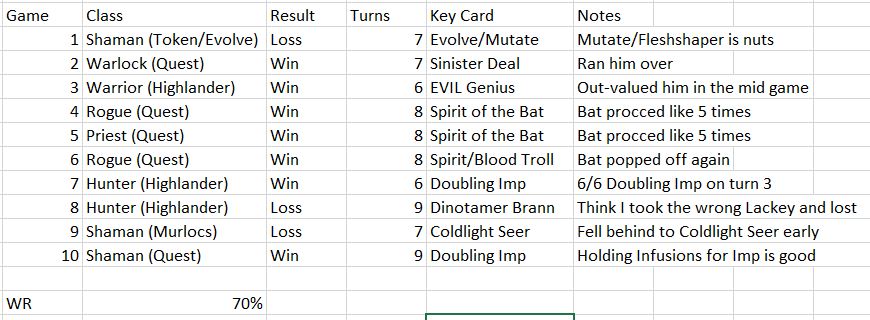
Now that’s pretty darn good! Although we actually didn’t encounter any N’Zoth decks (lol), we won 7 out of our 10 test games. In addition, our wins were pretty convincing, often ending the game on turns 6-8. As a personal note, the losses in games 8 and 9 felt extremely close, with only the loss in game 1 feeling like a true stomp. One card that stands out to me (I named it Key Card in three separate games) was actually Spirit of the Bat. In this deck, the card was a machine! I regularly was able to proc its effect at least 5 times, with all our token generation and sacrifice effects. To be honest, the only cards that I might replace in the list are Tekahn and History Buff. They were both fine (Tekahn was very helpful in game 3), but I’d like the chance to fit in Hench-Clan Hogsteed since I noticed a card I struggled to deal with early sometimes was EVIL Totem.
Although this deck performed quite well in testing, here are some changes I might suggest (note that the changes I've suggested are fairly light since this deck was already performing well as-is):
- -2 History Buff, -1 Dark Pharaoh Tekahn, +1 Soulfire, +2 Hench-Clan Hogsteed: Gives the deck some more burst and boar(d) control. It should be stronger vs. aggro but weaker vs. control.
- -2 History Buff, +1 Void Terror, +1 Barista Lynchen: Void Terror actually could be quite strong for this deck given the number of spare tokens we're looking to sacrifice. Barista Lynchenalso helps us generate even more extra resources with our Lackeys and Doubling Imps. It should be weaker vs. aggro but stronger vs. control.
What changes would you make to today’s deck? What decks have you been using to crush the early Doom in the Tomb meta? Let us know in the comments below. Join me next week to see how the new OP deck really isn’t that scary.
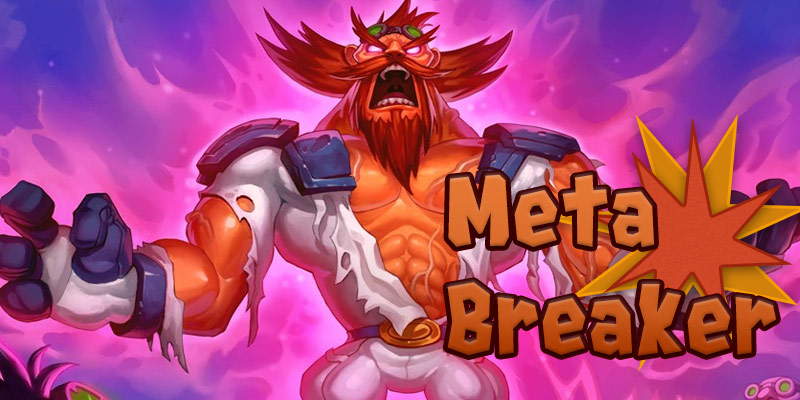
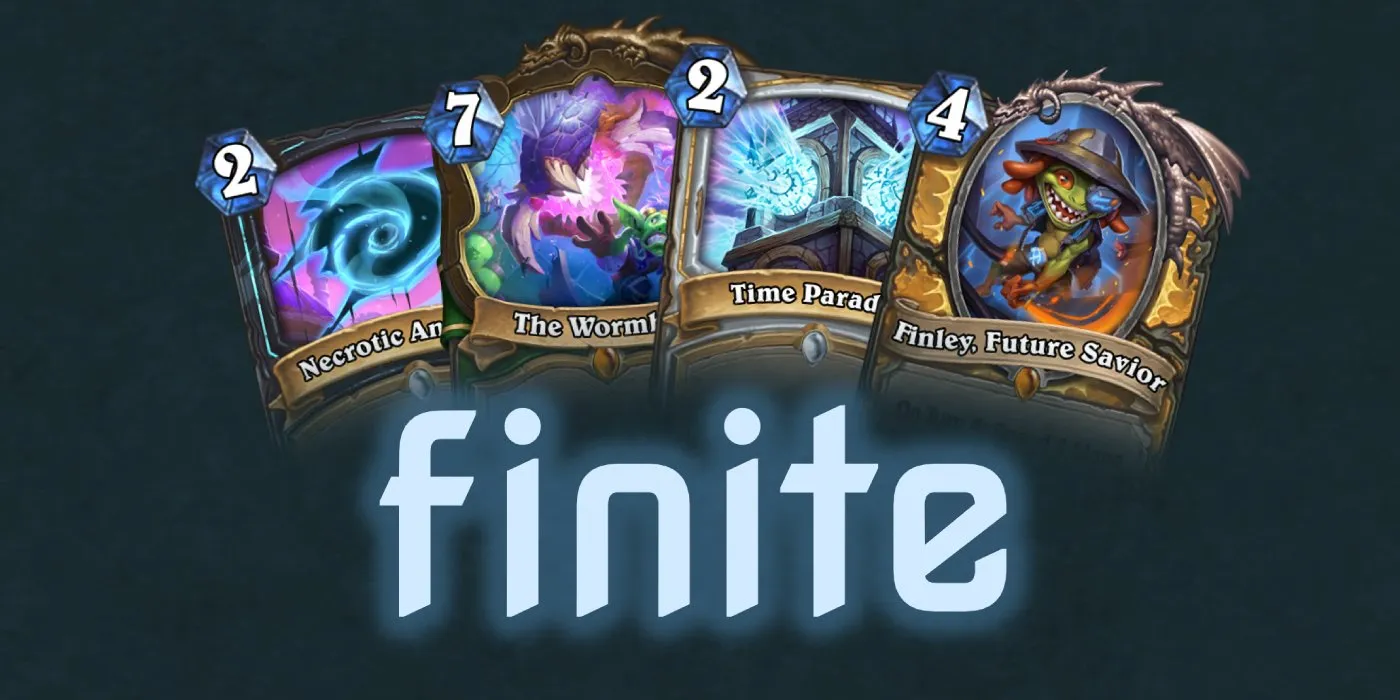
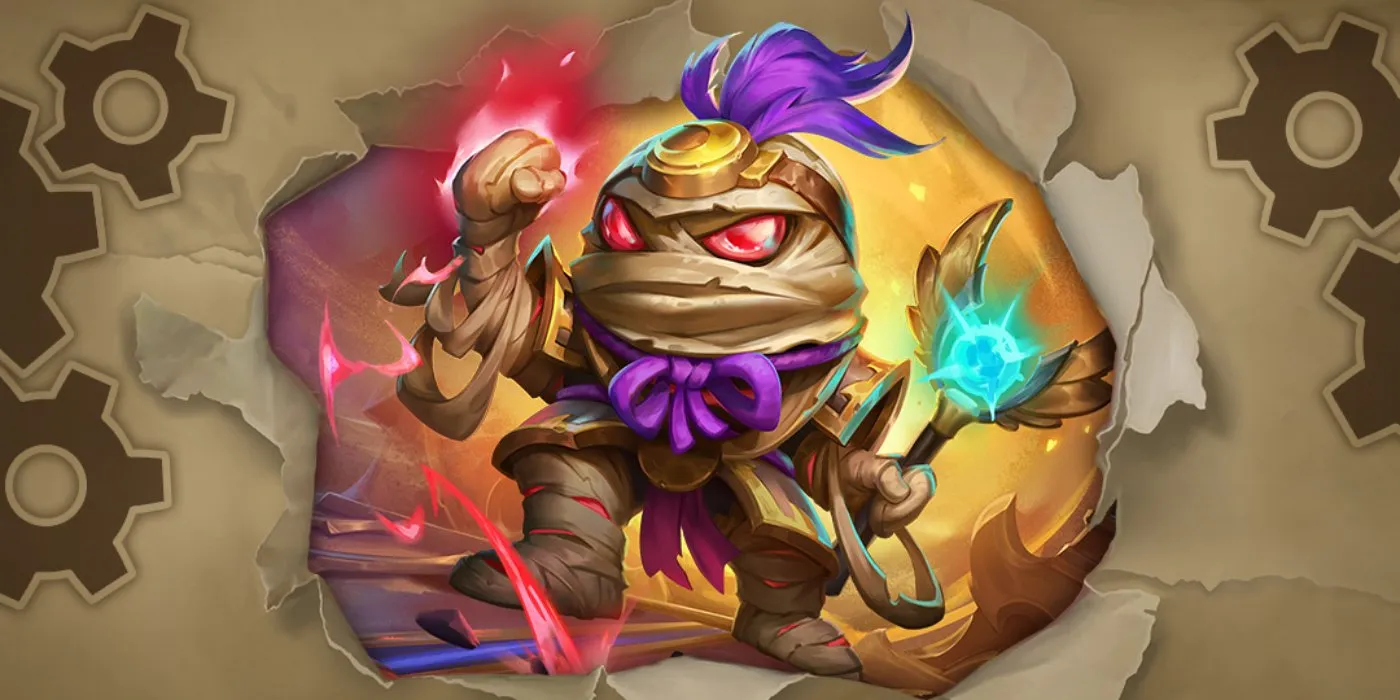
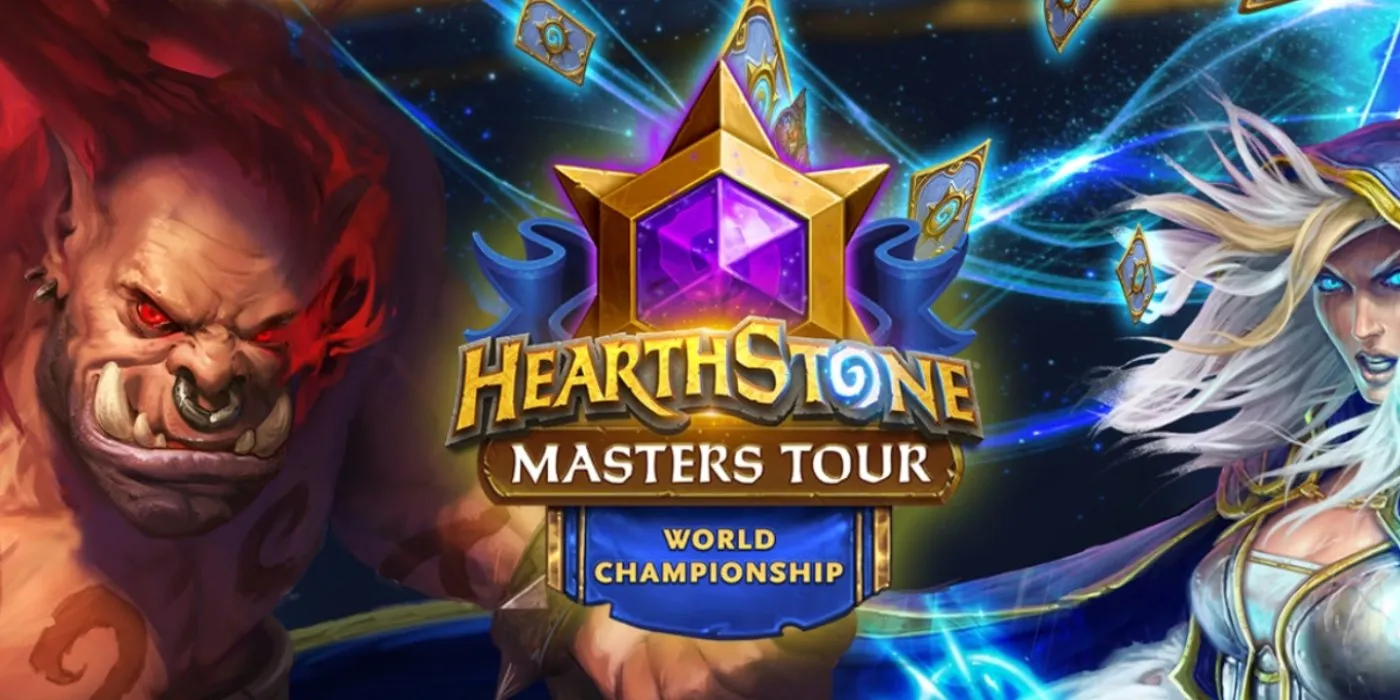
Comments
Sadly, doesn't work for me at all...
I made a quest shaman deck that uses history buff and he has been performing very well! I have no idea why but sometimes my opponents just completely ignore him and I am able to buff a minion by +3/+3 or +4/+4
You know, that's actually a pretty good idea! That deck generates so many Lackeys. I might give that a try.
I like your Excel spreadsheet :) I'm a sucker for data and notes.
Stats majors rise up :')
While doing day 1/2 nzoth decks was super fun, i'm already tired of it on day 3 because it's all i'm queuing into. So I'm just farming them with HW paladin. They can tech against it with Hakkar but it'll take a while for people to catch on and Hakkar is pretty bad in every other matchup for them.
I really like your articles. It's good to show people how to actually build decks and why things are in a deck as opposed to others.
Super glad to hear that! Thank you for reading :)
Edit: I'm curious- I've written sections talking about cards I considered but cut for various reasons, but I cut that part out to decrease article length. Would y'all be interested in reading that section too even though those cards aren't included in the final list?
Personally, I would find it enlightening. But I understand that some people don't want to read as many paragraphs about HS as I do.
Very well done - good written article and the decks are quite interesting!
Job Well done!
I was facing mostly aggresive and rush decks yesterday. A lot of games ended with me getting a Ragnaros fireball in the face. Hope it settles down a little soon ;)
Thanks for the great work, very thorough guide through the entire deck building process